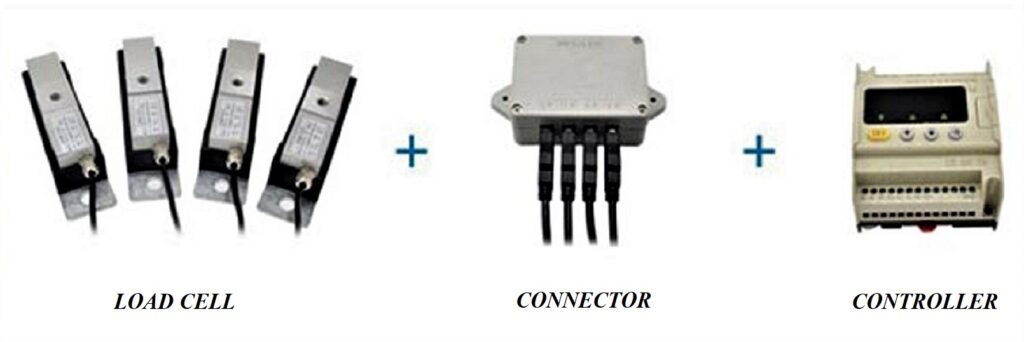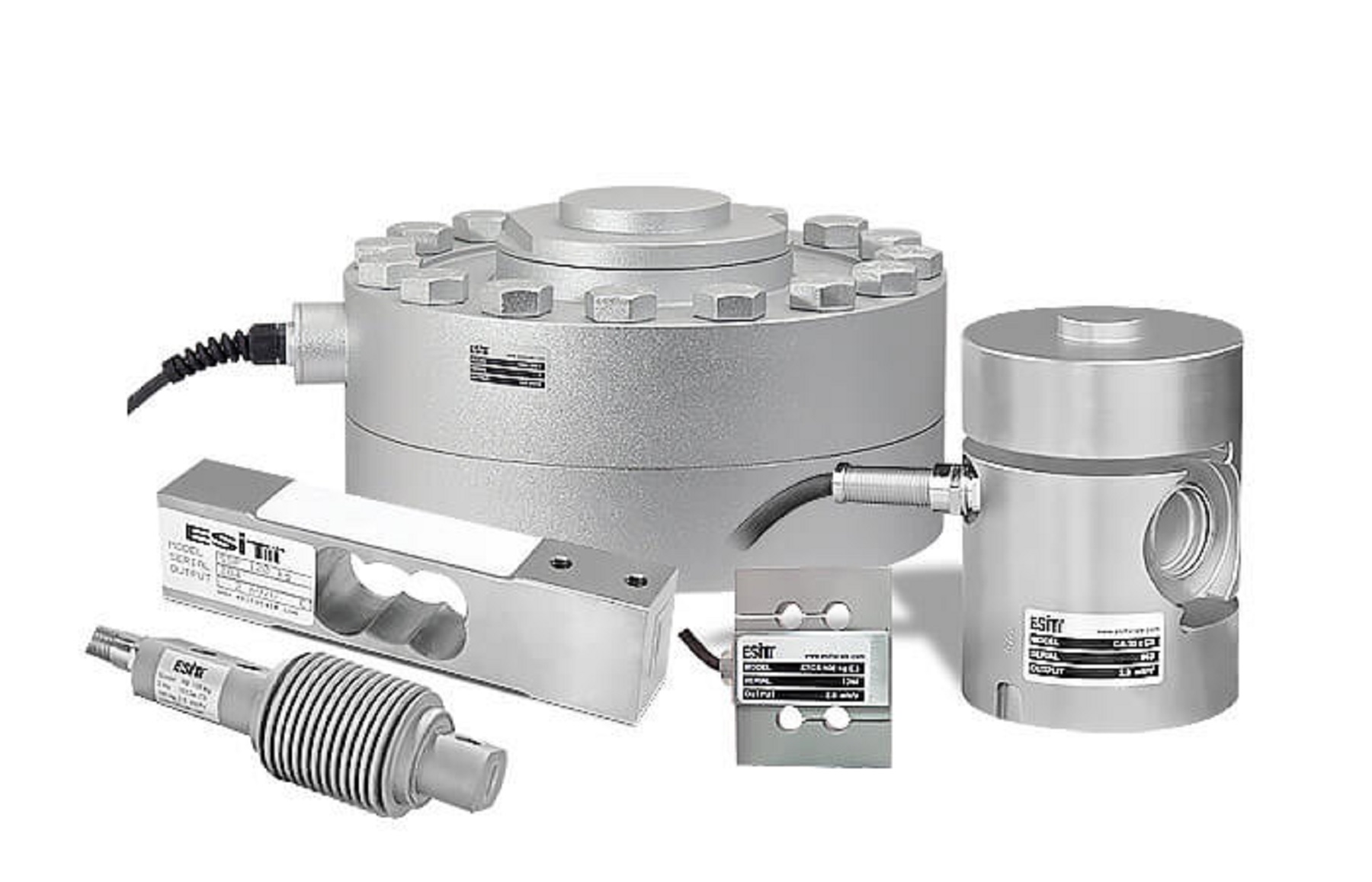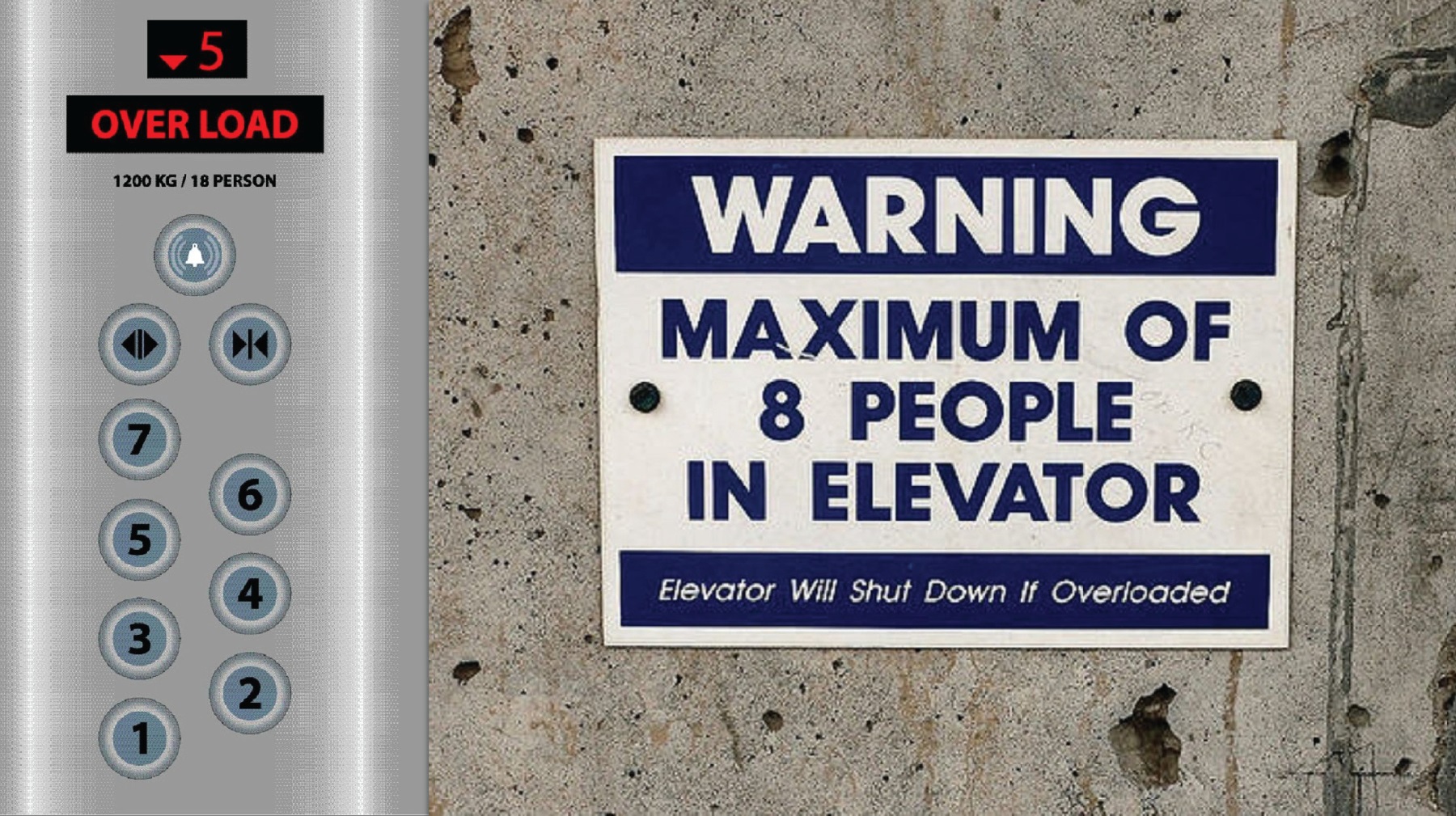EM – According to Elevator Magazine, the elevator that trapped 9 people in Ho Chi Minh City recently is a elevator with a maximum load of 450 kg, cabin size 800 mm x 1200 mm. We hypothesized, 9 people entering the elevator, there is a possibility that the elevator will overload but there is no warning and the elevator continues to operate. And in this case, it is possible that the overload warning system has malfunctioned.
The role of the load cell
Each elevator has a specified load, which is closely related to capacity, design, and purpose of use. In case the total weight of people or goods in the cabin exceeds the load, the elevator will not work and emit an overload signal. The elevator can detect allowable overload thanks to a properly installed overload warning system.

Diagram of an overload warning system in the cabin
The elevator overload warning system normally includes a load cell, junction box, controller and signaling device (sound, warning light). In which, the most important is the loadcell.
Depending on the design of each elevator manufacturer, the type and number of load cells will be different.
The working principle of the loadcell operates on the Wheatstone principle. This is the principle of balanced resistor bridge. Loadcell is a sensor that converts a force or weight into an electrical signal. The active value is proportional to the change in induced resistance in the resistor bridge, thus returning a proportional voltage signal.
There are many ways to classify load cells. If in the direction of force, we have loadcells in the form of compression, tension, bending, torsion. If classified by shape, we have loadcells in the form of cylinders, bridges, bars, Z-shaped, .. But now, usually classified according to the form of signals transmitted and received, we will have 2 types: analog loadcells and loadcell digital.

Loadcell digital
When a force is applied to the loadcell, the loadcell body will be changed (expanded or compressed) resulting in a change in the length of the metal Strain gauges glued to the loadcell body. Causes a change in the value of the resistors at Strain gauges. This results in a change in the output voltage.
The load cell senses the load inside the cabin, is connected to a controller, which calculates the weight and gives a warning signal if an overload has been installed.
The load sensor helps to minimize overload, potentially risking cable breakage, causing the cabin to fall freely, causing serious unsafety for users as well as affecting the durability of the elevator.
If the loadcell sensor is working properly, monitoring the load inside the cabin will ensure that the motor driving the cabin applies the right torque when traveling. This will help the motor run smoothly and have a longer life.
The advanced load sensor also acts as a scale, so in addition to the overload warning function, it also allows the elevator to warn and stop working when the weight is less than a certain level (under 15 kg to protect children as Zemic’s weighing system).
How is the overload test performed?
There are many causes of unwarranted elevator overload that users need to be aware of. In particular, maintenance and inspection will help early detect damage to overload warning devices so that elevator users can recognize and have solutions.
Elevators, when installed, must be inspected before being put into use. The inspection process is specified in great detail in Circular No. 12/2021/TT-BLDTBXH (Circular 12) promulgating the process of technical inspection of elevator safety under the management of the Ministry of Labor, War Invalids and Society, effective from November 15, 2021. In the inspection process, there are contents of checking the load of the elevator and the overload warning device.
According to Clause 4, Article 8 of Circular 12, elevators need to test dynamic load in 3 forms: No load, 100% rated load and 125% rated load.
At the rated 100% load test, the test of the car safety brake (for instantaneous safety gear or damped instantaneous safety brake) specifies: Test with test running speed, test method and evaluated according to point 4.2.3.1.2 TCVN 6904:2001. In particular, the elevator must meet the requirements for an instantaneous safety brake or an instantaneous safety brake with reduction, that is, the elevator moves downward at rated speed and with a load equal to the rated load.
For a load test level of 125% of rated load, the first requirement is a magnetic brake test. Accordingly, for the cabin to go down at the rated speed, then disconnect the motor power and brake power, the braking distance must not exceed the value specified by the manufacturer. The second requirement is to test the insurance brake. The safety brake test is carried out when the car is down, the test load is evenly distributed on the floor of the car, the brake is open. The test at below rated speed for instantaneous safety gear or damped instantaneous safety gear shall be carried out when the elevator is moving downward at rated speed and load equal to rated load. .
Circular 12 also requires testing of overload limiting devices. Specifically, Point e, Clause 4, Article 8: Checking overload limiting device: Evaluation according to point 2.8.3.2.4 QCVN 02:2019: When overload protection device and/or over protection device current for the electromechanical brake to operate, it must simultaneously activate the process of interrupting the current supply to the actuator. In other words, when the elevator is overloaded, the system will automatically stop the elevator from operating to ensure safety. If this does not take place, the overload warning device has been damaged.
In addition, the functional load test of the elevator, Point c, Clause 4, Article 8 of Circular 12 also clearly states: The method of testing and evaluation is according to point 4.2.4 TCVN 6904:2001. Accordingly, when testing this function, people load 125% of the rated load, then let the cabin go down to the lower landing. During the descent, the cabin is stopped at a number of floors, at each stop the cabin does not drift or drop.
How to fix overload?
The elevator load is proportional to the elevator cabin, specifically, with a large load, the cabin will have a large size and the pit space is also large. Of course, they must satisfy technical regulations and standards.
When installing an elevator, first of all, you must choose an elevator with a load suitable for the purpose of use. This helps customers save costs, installation space, avoid waste, avoid unwanted overload.
Elevator overload is not uncommon
If the elevator is often overloaded for any reason, like a weak person but often has to carry too much weight, the elevator’s electronic equipment and components will reduce their life quickly.
Frequent overloaded elevators also create great friction between the mechanical parts of the elevator, causing these devices to quickly wear out, damage, affecting the general operation of the elevator, etc.
It is recommended that elevators with a load capacity of 200 kg are used by 2-3 people. 300 kg load elevator for 3-4 people; 400-500 kg corresponds to 5-7 people and the scale from 525-630 kg is used for 5-8 people.
When an overload alarm appears, the people standing closest to the elevator door need to quickly step out to avoid affecting the elevator travel time of the surrounding areas, avoiding possible consequences for the passengers and elevator.
Users should also perform regular maintenance of the elevator so that the overload warning system is maintained. Experts recommend, after 6-12 months, we should recalibrate the loadcells to check the safety of the overload warning system, ensuring safety for elevator users./.



